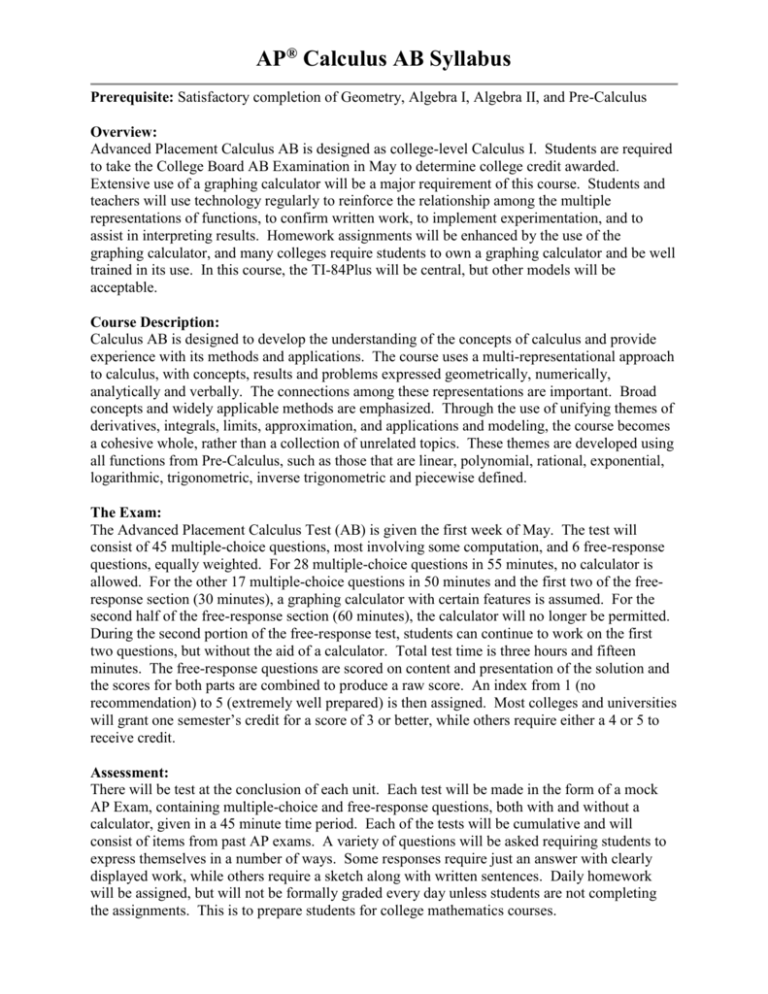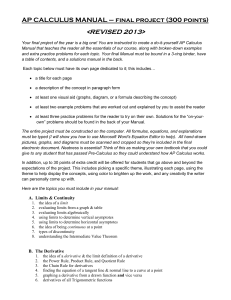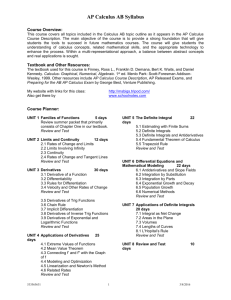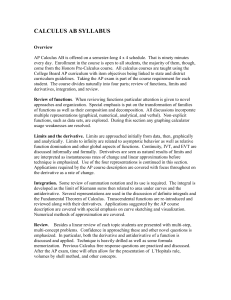
AP® Calculus AB Syllabus
Prerequisite: Satisfactory completion of Geometry, Algebra I, Algebra II, and Pre-Calculus
Overview:
Advanced Placement Calculus AB is designed as college-level Calculus I. Students are required
to take the College Board AB Examination in May to determine college credit awarded.
Extensive use of a graphing calculator will be a major requirement of this course. Students and
teachers will use technology regularly to reinforce the relationship among the multiple
representations of functions, to confirm written work, to implement experimentation, and to
assist in interpreting results. Homework assignments will be enhanced by the use of the
graphing calculator, and many colleges require students to own a graphing calculator and be well
trained in its use. In this course, the TI-84Plus will be central, but other models will be
acceptable.
Course Description:
Calculus AB is designed to develop the understanding of the concepts of calculus and provide
experience with its methods and applications. The course uses a multi-representational approach
to calculus, with concepts, results and problems expressed geometrically, numerically,
analytically and verbally. The connections among these representations are important. Broad
concepts and widely applicable methods are emphasized. Through the use of unifying themes of
derivatives, integrals, limits, approximation, and applications and modeling, the course becomes
a cohesive whole, rather than a collection of unrelated topics. These themes are developed using
all functions from Pre-Calculus, such as those that are linear, polynomial, rational, exponential,
logarithmic, trigonometric, inverse trigonometric and piecewise defined.
The Exam:
The Advanced Placement Calculus Test (AB) is given the first week of May. The test will
consist of 45 multiple-choice questions, most involving some computation, and 6 free-response
questions, equally weighted. For 28 multiple-choice questions in 55 minutes, no calculator is
allowed. For the other 17 multiple-choice questions in 50 minutes and the first two of the freeresponse section (30 minutes), a graphing calculator with certain features is assumed. For the
second half of the free-response section (60 minutes), the calculator will no longer be permitted.
During the second portion of the free-response test, students can continue to work on the first
two questions, but without the aid of a calculator. Total test time is three hours and fifteen
minutes. The free-response questions are scored on content and presentation of the solution and
the scores for both parts are combined to produce a raw score. An index from 1 (no
recommendation) to 5 (extremely well prepared) is then assigned. Most colleges and universities
will grant one semester’s credit for a score of 3 or better, while others require either a 4 or 5 to
receive credit.
Assessment:
There will be test at the conclusion of each unit. Each test will be made in the form of a mock
AP Exam, containing multiple-choice and free-response questions, both with and without a
calculator, given in a 45 minute time period. Each of the tests will be cumulative and will
consist of items from past AP exams. A variety of questions will be asked requiring students to
express themselves in a number of ways. Some responses require just an answer with clearly
displayed work, while others require a sketch along with written sentences. Daily homework
will be assigned, but will not be formally graded every day unless students are not completing
the assignments. This is to prepare students for college mathematics courses.
Primary Texts:
Larson, Edwards. Calculus of a Single Variable. Brooks/Cole Cengage Learning, 2010, Ninth
Edition.
Cade, Caldwell, and Lucia. Fast Track to a 5: Preparing for the AP* Calculus AB and BC
Examinations. Brooks/Cole Cengage Learning, 2015.
Supplemental Texts:
AP Calculus Multiple Choice Questions, 1969-1997
AP Calculus Free Response Questions, 1969-1978; 1979-1988; 1989-1998
AB Free Response Questions posted on apcentral (1999-2006)
Finney, Ross L., Franklin D. Demana, Bert K. Waits, and Daniel Kennedy. Calculus: Graphical,
Numerical, Algebraic. Boston: Pearson Prentice Hall, 1999.
Lederman, David. Multiple-Choice & Free-Response Questions in Preparation for the AP
Calculus (BC) Examination. New York: D & S Marketing Systems, Inc., 1999.
Ostebee, Arnold, and Paul Zorn. Calculus from Graphical, Numerical, and Symbolic Points of
View. Boston: Houghton Mifflin, 1997.
Course Outline:
Unit 1:
Families of
Functions
(10 days)
(Unit tests for all units
are included in days
indicated.)
1st Semester
Functions as models of change
o Representing functions using the “Rule of Four”
o Domain & range, increasing & decreasing, even & odd, concavity of
graphs, zeros, end behavior, asymptotic behavior graphically and in
terms of limits involving infinity
Linear functions
o Slope as a rate of change
Exponential functions
o Applications
Logarithmic functions
Trigonometric functions
Power functions, polynomials and rational functions
Transformation of functions
o Inverse functions
o Composition of functions
o Shifts, stretches, compressions
Working with functions in verbal, graphical, algebraic and tabular depictions
Calculator Refresher (activity)
o Plotting graphs, finding roots, window manipulation, finding values
of functions, using tables, “lies my calculator told me,” dangers of
intermediate rounding
Unit 2:
Limits
(10 days)
Unit 3:
The Derivative
(20 days)
Development of the derivative of a function at a point using the derivation of
instantaneous speed from average speed
o Introduction to the instantaneous rate of change of a function at a
point as the slope of the graph at that point
Introduction to limits
o Intuitive concept of the limiting process
o Calculating limits from numerical data
o Calculating limits using algebra
o Calculating limits from graphs of functions
o Formal definition of limit
o Properties of limits
o One- and two-sided limits
o Proving limits exist
o Limits at infinity and end behavior
Continuity
o Definition of continuity (limits)
o Proving continuity
o Continuity of sums, products, and quotients of functions
o Continuity of composite functions
o Recognizing continuous functions (graphically, algebraically,
numerically)
Concept of the derivative
o Instantaneous rate of change from average rate of change
o Definition of the derivative as the limit of the difference quotient –
analytical depiction
o Graphical depiction of limiting process – secant line to tangent line
o Determining the derivative of a function numerically
Derivative of a function at a point
o Slope of tangent line to graph of a function at a point including
cases where there are vertical or infinitely many tangents
o Slope of curve at a point
o Approximating rates of change of functions from graphs and tables
of data
o Finding derivatives of a function at a point using calculators
The derivative function
o Definition of first and second derivative functions
o What derivatives tells us graphically
Increasing/decreasing behavior, concavity (signs of f’ and
f”), inflection points
o Working with derivative functions graphically, analytically, verbally
and numerically
Understanding the corresponding characteristics between
the graphs of f, f’ and f”
Interpreting the derivative
o Equations of motion
o Interpreting equations involving derivatives verbally and vice versa
Finding derivatives for basic functions
Finding derivatives of sums, products, and quotients of functions
o Product and quotient rules
Finding derivatives of composite functions using the chain rule
Finding derivatives of implicitly defined functions
o Using implicit differentiation to find the derivative of an inverse
function
Unit 4:
Using the Derivative
(20 days)
Unit 5:
Integrals
(20 days)
Analysis of curves of functions
o Monotonicity and concavity/inflection points
Local extrema
o Critical points
o First derivative test
o Second derivative test
Global extrema and upper and lower bounds of functions
Optimization and modeling rates of change
o Applications to marginality
o Related rate problems (student project)
Theorems about continuous and differentiable functions and their geometric
consequences
o Extreme Value Theorem
o Mean Value Theorem
o Rolle’s Theorem
o Increasing Function Theorem
Newton’s Method
Differentials
Development of the definite integral as the total accumulated change of a
function on an interval using velocity to find distance traveled
Graphical development of the definite integral as a limit of Riemann sums
o Left- and right-hand sums and limits
o Calculating Riemann Sums
Interpretation of the definite integral of the rate of change of a quantity over
an interval as the change in quantity over the interval:
b
a
f ' ( x)dx f (b) f (a)
Interpretation of the definite integral as an area
Average value of a function on an interval
The Fundamental Theorem of Calculus
Computing definite integrals using the Fundamental Theorem, graphically,
and numerically
Properties of definite integrals
o Even and odd functions
o Additivity, linearity, multiplying by a constant
Using the calculator to evaluate a definite integral
Families of antiderivatives
o Visualizing antiderivatives using slopes – the graph of f from the
graph of f’
Second Fundamental Theorem
o Finding a particular antiderivative with the Fundamental Theorem
and analyzing it analytically and graphically
Finding specific antiderivatives using initial conditions
Integration by Substitution
Approximating definite integrals represented algebraically, graphically, and
by tables of values
o Trapezoidal Rule
o Simpson’s Rule
o Error Analysis
Unit 6:
Transcendental
Functions
(24 days)
Unit 7:
Differential
Equations
(15 days)
Unit 8:
Integration
Applications
(9 days)
AP® Exam Review &
AP® Exam
(12 days)
Post AP® Exam
Activities
(20 days)
2nd Semester
Finding derivatives for basic functions
o Natural Logarithms
o Inverse Functions
o Exponential Functions
o Inverse Trigonometric Functions
Finding derivatives for basic functions
o Natural Logarithms
o Inverse Functions
o Exponential Functions
o Inverse Trigonometric Functions
The meaning of differential equations and their solutions
o General solutions
o Initial value problems, particular solutions
Solution of differential equations:
o Graphical/geometric interpretation using slope fields to find solution
curves given initial conditions
o Numerically (Euler’s Method)
o Analytically (Separation of Variables)
Application of differential equations to model real-world phenomenon
o Exponential (y’=ky) & Logistic models
o Models of population growth
o Newton’s Law of Heating & Cooling
Integrals are used to model various real-world phenomena. Emphasis is
placed on visualizing models as Riemann sums and representing them with
its limit as a definite integral. Applications include:
o Areas of regions
o Volumes
o Volumes of solids of revolution
o Volumes of regions of known cross-section
Focus is on synergizing all topics covered and identifying students’
weaknesses.
Students continue to work in teams using previous AP ® exams and sample
tests.
Practice exams taken
“Instructional tool” creation
o Students will develop videos, tutorial CDs, children’s books,
calculator programs, or any other tool that could be used to support
the teaching of some area of calculus.
Student-Led Conferences
o Each student prepares for and conferences with their parents to
demonstrate their mastery of the major concepts of single-variable
Calculus.
o The Calculus portfolio is used to help guide discussion










